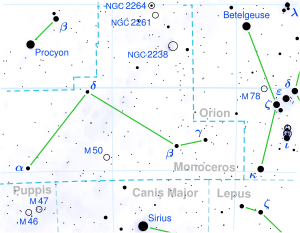Location of Scholz's Star in the constellation Monoceros | |
| Observation data Epoch J2000.0 Equinox J2000.0 | |
|---|---|
| Constellation | Monoceros |
| Right ascension | 07h 20m 03.254s[1] |
| Declination | −08° 46′ 49.90″[1] |
| Apparent magnitude (V) | 18.3[2] |
| Characteristics | |
| Red dwarf | |
| Spectral type | M9.5±0.5[3] |
| Brown dwarf | |
| Spectral type | T5.5±0.5[3] |
| Astrometry | |
| Radial velocity (Rv) | 82.4±0.3[3] km/s |
| Proper motion (μ) | RA: −40.3±0.2[2][4] mas/yr Dec.: −114.8±0.4[2][4] mas/yr |
| Parallax (π) | 147.1 ± 1.2 mas |
| Distance | 22.2 ± 0.2 ly (6.80 ± 0.06 pc) |
| Absolute magnitude (MV) | 19.4[5] |
| Orbit[3] | |
| Primary | Scholz's Star A |
| Companion | Scholz's Star B |
| Period (P) | 8.06+0.24 −0.25 yr |
| Semi-major axis (a) | 0.320±0.003" (2.173+0.028 −0.029 AU) |
| Eccentricity (e) | 0.240+0.009 −0.010 |
| Inclination (i) | 106.9±0.4° |
| Longitude of the node (Ω) | 240.21±0.28° |
| Periastron epoch (T) | 2015/09/16+23−28 |
| Argument of periastron (ω) (secondary) | 1±5° |
| Details | |
| Red dwarf | |
| Mass | 0.095±0.006[3] M☉ |
| Radius | 0.992+0.006 −0.007[3] RJup |
| Age | 3–10[2] Gyr |
| Brown dwarf | |
| Mass | 0.063±0.004[3] M☉ |
| Radius | 0.822+0.016 −0.015[3] RJup |
| Other designations | |
| Database references | |
| SIMBAD | data |
Scholz's Star /ˈʃoʊlz(əz)/ (WISE designation WISE 0720−0846 or fully WISE J072003.20−084651.2) is a dim binary stellar system 22 light-years (6.8 parsecs) from the Sun in the constellation Monoceros near the galactic plane.[2] It was discovered in 2013 by astronomer Ralf-Dieter Scholz. In 2015, Eric Mamajek and collaborators reported that the system passed through the Solar System's Oort cloud roughly 70,000 years ago,[2] and dubbed it Scholz's Star.
- ^ a b Cutri, Roc M.; Skrutskie, Michael F.; Van Dyk, Schuyler D.; Beichman, Charles A.; Carpenter, John M.; Chester, Thomas; Cambresy, Laurent; Evans, Tracey E.; Fowler, John W.; Gizis, John E.; Howard, Elizabeth V.; Huchra, John P.; Jarrett, Thomas H.; Kopan, Eugene L.; Kirkpatrick, J. Davy; Light, Robert M.; Marsh, Kenneth A.; McCallon, Howard L.; Schneider, Stephen E.; Stiening, Rae; Sykes, Matthew J.; Weinberg, Martin D.; Wheaton, William A.; Wheelock, Sherry L.; Zacarias, N. (2003). "VizieR Online Data Catalog: 2MASS All-Sky Catalog of Point Sources (Cutri+ 2003)". CDS/ADC Collection of Electronic Catalogues. 2246: II/246. Bibcode:2003yCat.2246....0C.
- ^ a b c d e f Cite error: The named reference
Mamajek2015was invoked but never defined (see the help page). - ^ a b c d e f g h Cite error: The named reference
Dupuy2019was invoked but never defined (see the help page). - ^ a b Cite error: The named reference
Burgasser2015was invoked but never defined (see the help page). - ^ Cite error: The named reference
FAQwas invoked but never defined (see the help page). - ^ Cite error: The named reference
ScienceDaily-2015-02-17was invoked but never defined (see the help page). - ^ "2MASS J07200325-0846499". SIMBAD. Centre de données astronomiques de Strasbourg. Retrieved 2015-02-18.
